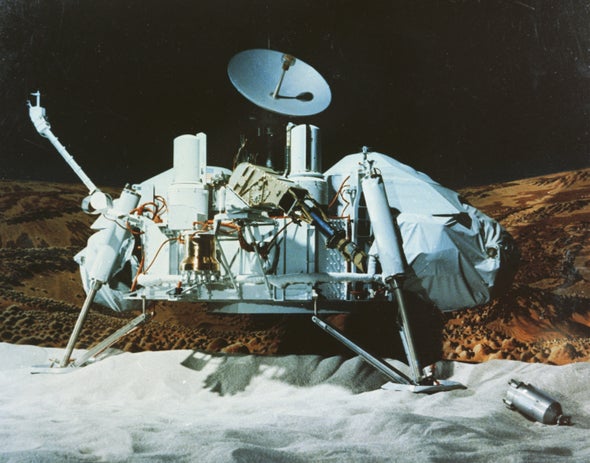(单词翻译:单击)
听力文本
This is Scientific American's 60-second Science, I'm Christine Herman.
(CLIP: "Houston, Tranquility Base here. The Eagle has landed.")
July 20 marks 50 years since human beings first landed on the moon. That momentous day in 1969 made astronauts Neil Armstrong and Buzz Aldrin household names. But years before that, a lesser-known figure was on a mission to make that first moon landing possible.
His name was John Houbolt. The son of Dutch immigrants, Houbolt grew up on a farm in Joliet, Ill. He studied engineering at the University of Illinois and eventually worked his way to NASA.
It was there, in the early 1960s, that he put his career on the line to champion what was, at the time, an unpopular idea—but would ultimately be critical to getting Apollo 11 to the moon and safely back.
"John faced a mixture of indifference, at times, abuse and, at times, ridicule that he never forgot until things started to change, and engineers started to realize his data might be right." Todd Zwillich, author of the new Audible Original spoken-word book about Houbolt's life. It's called The Man Who Knew the Way to the Moon.

So what was Houbolt's unpopular idea? He championed what's called lunar orbit rendezvous. The concept involves sending a spacecraft into orbit around the moon—and from there, sending only a small, lightweight craft down to the moon's surface, instead of the entire ship.
Zwillich says while Houbolt didn't invent the idea, he was the one who started to apply it to the technologies that were within NASA's grasp at the time.
"Most of the people who know the most about this mission feel that without lunar orbit rendezvous, Apollo couldn't have succeeded. And without John Houbolt, you probably would not have had lunar orbit rendezvous."
Zwillich's book also explores the kinds of challenges NASA engineers face today, as they make plans to get back to the moon and, ultimately, to Mars.
"When you talk about Mars, gosh, 150 million miles, orders of magnitude of a bigger problem. Do we do some form of Martian orbit rendezvous? Do we send a station, build a station in Martian orbit that we can stage down to the surface to manage all that mass? A lot of problems to think about."
Those problems, he says, create plenty of debates today. With the story of John Houbolt as an example, something considered highly unlikely now might be the key to eventually putting people on the Red Planet.
Thanks for listening for Scientific American — 60-Second Science. I'm Christine Herman.
参考译文
这里是科学美国人——60秒科学系列,我是克里斯汀·赫尔曼。
(音频片段:“休斯敦,这里是宁静基地。‘鹰’号登月舱已经着陆。”)
7月20日是人类首次登上月球50周年纪念日。1969年那重要的一天使宇航员尼尔·阿姆斯特朗和巴兹·奥尔德林家喻户晓。但在那之前的数年,一个鲜为人知的人物正在执行一项使首次登月成为可能的任务。
他的名字是约翰·霍博尔特。霍博尔特是荷兰移民的后代,在伊利诺伊州乔利埃特的一处农场长大。他在伊利诺伊大学学习工程学,最终凭借努力进入美国国家航空航天局(简称NASA)工作。
上世纪60年代早期,正是在那里,他将自已的职业生涯押在了当时不受欢迎的想法上,而这个想法最终对阿波罗11号成功登月并安全返回起到了至关重要的作用。
“约翰面对着时不时的冷漠、谩骂和嘲笑,他从未忘记,直到事态开始发生变化,工程师们开始意识到他的数据可能是正确的。”托德·兹威里奇说到,他是关于霍博尔特生平的原创有声书的作者。这本书名为《知道通往月球之路的人》。
那霍博尔特不受欢迎的想法是什么?他捍卫所谓的“月球轨道交会”。这个概念包括将宇宙飞船发射到绕月轨道,然后从那里将一艘小且轻的航天器送到月球表面,而不是整个宇宙飞船。
兹威里奇表示,虽然这个想法不是霍博尔特发明的,但他是开始将其应用于NASA当时所掌握技术的人。
“大多数了解这次任务的人都认为,没有月球轨道交会,阿波罗就不可能成功。而如果没有约翰·霍博尔特,可能就不会有月球轨道交会。”
兹威里奇的书还探索了NASA工程师今天面临的各种挑战,因为他们计划重返月球,最终到达火星。
“当你谈到火星时,天哪,1.5亿英里,这是更大问题的数量级。我们是否进行某种形式的火星轨道交会?我们要不要在火星轨道上建立一个空间站,以降落到火星表面来处理所有的质量?有很多问题需要考虑。”
他说,这些问题在今天引发了大量争论。以约翰·霍博尔特的故事为例,一些现在看来不太可能的事情可能是最终将人类送上火星的关键。
谢谢大家收听科学美国人——60秒科学。我是克里斯汀·赫尔曼。
译文为可可英语翻译,未经授权请勿转载!
重点讲解
重点讲解:
1. grow up 长大成人;
She grew up in Tokyo.
她在东京长大。
2. on the line 岌岌可危;冒极大的险;
He wouldn't put his career on the line to help a friend.
他不会为了帮助朋友而让自己的事业受到威胁。
3. at times 有时;间或;
The debate was highly emotional at times.
辩论有时变得异常情绪化。
4. get back to 恢复(原状);回到;
I didn't get back to Brussels until after my demob.
我在复员之后才回到了布鲁塞尔。


